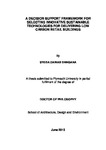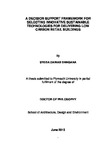A DECISION SUPPORT FRAMEWORK FOR SELECTING INNOVATIVE SUSTAINABLE TECHNOLOGIES FOR DELIVERING LOW CARBON RETAIL BUILDINGS
| dc.contributor.supervisor | GOODHEW, STEVE | |
| dc.contributor.author | DANGANA, SYEDA | |
| dc.contributor.other | School of Art, Design and Architecture | en_US |
| dc.date.accessioned | 2015-07-01T11:28:38Z | |
| dc.date.available | 2015-07-01T11:28:38Z | |
| dc.date.issued | 2015 | |
| dc.identifier | 10243318 | en_US |
| dc.identifier.uri | http://hdl.handle.net/10026.1/3387 | |
| dc.description | Full version unavailable due to 3rd party copyright restrictions | |
| dc.description.abstract |
There is an urgent need to adopt innovative sustainable technologies (ISTs) to reduce energy consumption and carbon emissions whilst improving process efficiency of existing retail buildings, due to rising energy prices and the impacts of retail buildings on the environment. Despite their reported advantages, exhibited performance and numerous policies and legislations that encourage their adoption, there is a slow uptake of ISTs in the retail sector. This is due to the fact that the majority of stakeholders consider the task of selecting ISTs as a complex multi-attribute, multi-valued problem involving a large number of stakeholders with numerous, often conflicting objectives. To overcome this problem, the thesis develops a Decision Support Framework to assist stakeholders in the selection of ISTs for delivering low carbon retail buildings. Firstly focusing on the wider retail construction industry, followed by an in-depth case study of a leading UK retail contractor, the drivers and barriers faced by stakeholders in the retail construction industry during the selection of ISTs were identified. The underlying cause to the slow uptake of ISTs (complex decision-making problem) and the need to optimise the use of ISTs were investigated. The results identified the lack of a Decision Support Framework for the selection of ISTs for stakeholders in the retail construction industry. To address the problem, the research developed a Decision Support Framework to assist stakeholders in the complex decision-making task of selecting ISTs. The developed Decision Support Framework was first validated with a leading UK retail contractor and proved favourable; facilitating the decision-makers in the selection process and resulting in the successful selection of eight ISTs. A more general validation was conducted to ensure the Decision Support Framework was applicable to the wider construction industry. The results indicated that the framework was an effective mechanism to optimise the selection of ISTs by improving the decision-making process; it could be used by other stakeholders and also transferable to other building types for selecting ISTs. The thesis contributes to the knowledge related to decision-making and construction management research by developing a Decision Support Framework to assist stakeholders in the selection of ISTs to deliver low carbon retail buildings. In addition, it identifies the drivers for and barriers to selecting ISTs for existing retail buildings; key stakeholders in the selection of ISTs, a set of selection criteria used by clients/developers and designers/constructors and a database of ISTs that can be implemented by stakeholders to achieve low carbon retail buildings. | en_US |
| dc.description.sponsorship | WATES | en_US |
| dc.language.iso | en | en_US |
| dc.publisher | Plymouth University | en_US |
| dc.subject | Low Carbon Retail Buildings | en_US |
| dc.subject | Innovative Sustainable Technologies | |
| dc.subject | Decision Support Framework | |
| dc.title | A DECISION SUPPORT FRAMEWORK FOR SELECTING INNOVATIVE SUSTAINABLE TECHNOLOGIES FOR DELIVERING LOW CARBON RETAIL BUILDINGS | en_US |
| dc.type | Thesis | |
| plymouth.version | Edited version | en_US |
| dc.identifier.doi | http://dx.doi.org/10.24382/3343 | |
| dc.identifier.doi | http://dx.doi.org/10.24382/3343 |
Files in this item
This item appears in the following Collection(s)
-
01 Research Theses Main Collection
Research Theses Main



